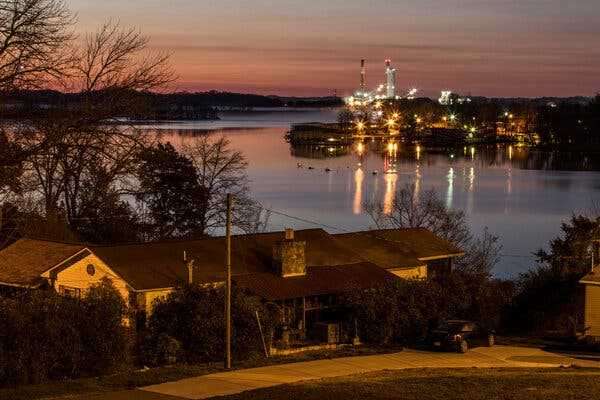The regulation, which was welcomed by industry groups, limited the role of states in enforcing the Clean Water Act.
-
Send any friend a story
As a subscriber, you have “>10 gift articles to give each month. Anyone can read what you share.
Give this article
- Read in app

The Tennessee Valley Authority’s Fossil Plant, on the Cumberland River in Gallatin, Tenn. The plant was involved in legal action related to the Clean Water Act.
WASHINGTON — The Supreme Court on Wednesday reinstated an environmental regulation from the Trump administration that restricted the role states play in enforcing the Clean Water Act.
The court’s brief, unsigned order gave no reasons, which is typical when the justices act on an emergency application.
Four justices dissented, saying the majority had used a case on what critics call the court’s shadow docket to issue a significant ruling without adequate consideration.
Writing for the dissenters, Justice Elena Kagan said the court should have allowed the appeal to proceed in the ordinary course.
“The applicants have given us no good reason to think that in the remaining time needed to decide the appeal, they will suffer irreparable harm,” she wrote. “By nonetheless granting relief, the court goes astray.”
The Biden Administration’s Environmental Agenda
President Biden is pushing stronger regulations, but faces a narrow path to achieving his goals in the fight against global warming.
- Biden’s Agenda: President Biden’s plan to fight global warming faces legal, legislative and political challenges that could dismantle it entirely.
- Clean Energy: President Biden wants to eliminate planet-warming emissions from the power sector by 2035, but the nation’s biggest federal utility is betting on gas.
- Tailpipe Standards: The administration is moving to introduce new limits on pollution from heavy trucks and restore California’s ability to set its own rules on auto emissions.
- Air Pollution: The administration recently restored regulations on the release of mercury, a neurotoxin linked to developmental damage in children, from coal-burning power plants.
- Wastewater Projects: The infrastructure bill includes funding to upgrade sewer and drainage systems. Will the money go where it’s most needed?
She added: “That renders the court’s emergency docket not for emergencies at all. The docket becomes only another place for merits determinations — except made without full briefing and argument.”
Chief Justice John G. Roberts Jr. and Justices Stephen G. Breyer and Sonia Sotomayor joined Justice Kagan’s dissent.
The Clean Water Act envisions a role for states in issuing permits for discharges into the nation’s waters. Industry groups have long been frustrated by what the application called incongruities and ambiguities in an earlier regulation, in place for 50 years, which they said had allowed states to drag out and effectively veto projects on grounds other than the consideration of water quality.
The groups welcomed the new regulation, adopted in 2020, which narrowed the criteria for state certification, tightened deadlines and stopped states from imposing what they called “project-killing conditions.”
Twenty states and the District of Columbia, along with environmental groups, had challenged the regulation, saying it was at odds with federal law. After President Biden took office, the Environmental Protection Agency said it would revise the rule and asked three judges presiding over challenges to return them to the agency.
Notably, though, the E.P.A. did not ask the judges to vacate the regulation while it worked on a new one. Two judges, in South Carolina and Pennsylvania, did what the agency asked.
But Judge William H. Alsup, of the Federal District Court in San Francisco, vacated the regulation. The move was justified by “the lack of reasoned decision-making and apparent errors in the rule’s scope of certification, the indications that the rule contravenes the structure and purpose of the Clean Water Act,” he said, and the fact that the “E.P.A. itself has signaled it could not or will not adopt the same rule.”
After the U.S. Court of Appeals for the Ninth Circuit, in San Francisco, refused to block Judge Alsup’s ruling while an appeal moved forward, Louisiana and other states led by Republicans, along with industry groups, filed an emergency application asking the Supreme Court to revive the regulation. They said that Judge Alsup had acted without considering administrative procedures or finding that the regulation was unlawful.
Writing on behalf of the E.P.A., Elizabeth B. Prelogar, the U.S. solicitor general, urged the Supreme Court to deny the emergency application. Judge Alsup’s ruling, she wrote, merely reinstated the old regulation, which had been in place for a half-century. The 2020 regulation, she added, would most likely be replaced by next year.
Ms. Prelogar’s brief included a significant concession. “The federal respondents,” she wrote, “agree with applicants that the district court lacked authority to vacate the 2020 rule without first determining that the rule was invalid.” But she said that was not reason enough to block his ruling.
In her dissent, Justice Kagan wrote that the court’s ruling was a solution in search of a problem.
“The request for a stay rests on simple assertions — on conjectures, unsupported by any present-day evidence, about what states will now feel free to do,” she wrote. “And the application fails to show that proper implementation of the reinstated regulatory regime — which existed for 50 years before the vacated rule came into effect — is incapable of countering whatever state overreach may (but may not) occur.”
“The applicants have not identified a single project that a state has obstructed in the five months since the district court’s decision,” Justice Kagan continued. “Still more, they have not cited a single project that the court’s ruling threatens, or is likely to threaten, in the time before the appellate process concludes.”
Source: nytimes.com



